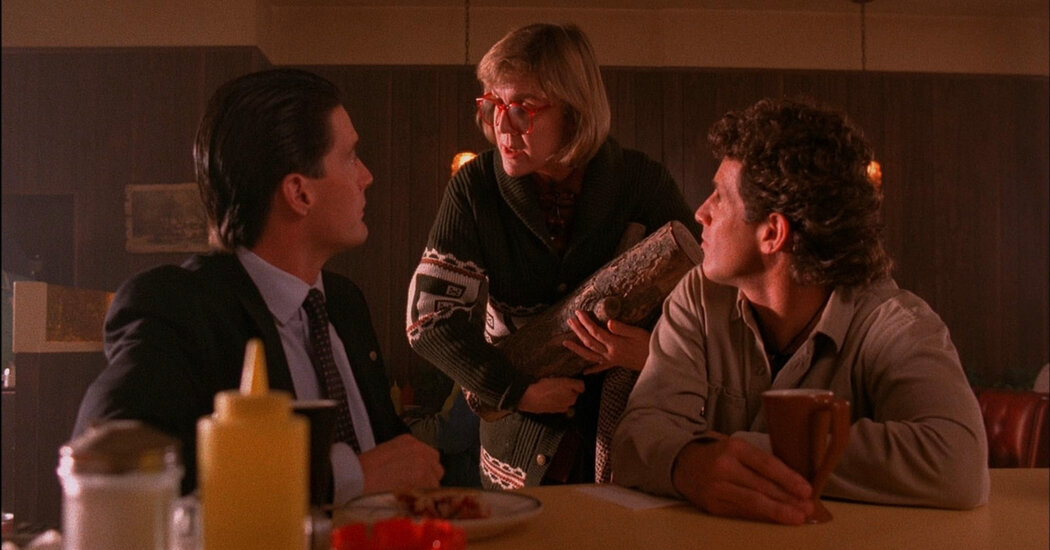Is Twin Peaks probably the most American TV collection ever made? It may not be the primary collection {that a} nation would fortunately select as its calling card: a homicide thriller, surreal and haunting, that entails the sacrifice of innocents towards a backdrop of mountain grandeur and small-town diners. In it David Lynch who died aged 78lifted the planks of the American dream and launched a swarm of evil spirits from beneath.
However the Twin Peaks that Lynch made with Mark Frost is filled with America, struck by its physicality as splendidly as any sweeping Western epic or Georgia O’Keefe image. From his personal initial creditswho traverses misty forests and the sparks of logging equipment, he sees a spot of magnificence and violence, teeming with animistic spirits that predate political boundaries and even human settlement.
It is also a present fabricated from Americana, espresso and cherry pie, yearbook photographs and doo-wop ballads. Lynch, who spent a part of his childhood within the Northwest, is usually described as a filmmaker who reveals the rot behind excellent American facades, and that is not incorrect. (Within the film Twin Peaks: Fire Walks With Me he even launched his idea of “garmonbozia,” or worldly ache and sorrow, within the type of that almost all American of mid-century facet dishes, creamed corn.)
However there’s nothing cynical or mocking about his portrayal in Twin Peaks. It is filled with darkness however lacks contempt. Just like the dictated observations of FBI Particular Agent Dale Cooper (Kyle MacLachlan), it is the work of a honest weirdo, pressured to dig deeper — underneath the grass, within the forest, even past the borders of the Earth airplane — to get to the horror and the transcendence of being human.
This, to say the least, made Twin Peaks a stunner to look at on prime-time TV the week it premiered on ABC in 1990. It was much more gorgeous to see it not simply in successful, however a monstrous pop-culture sensation—this from the art-house director who had launched the phantasmagorical “Blue Velvet” just a few years in the past.
However Twin Peaks was not a lofty piece of movie that was diminished to a decrease medium. It was unashamedly business tv, combining parts of highschool drama, police procedural, and cleaning soap opera. (To not point out the cleaning soap opera of the present, “Invitation to Love.”) Sure, there have been inexplicable interludes within the Black Lodge, a cryptic speaking large and the wild-eyed ghost killer Bob — however first there was the popcorn-entertainment whodunit with the tagline: “Who Killed Laura Palmer ?”
Twin Peaks burned scorching and quick. It is grow to be shorthand for each the type of risk-taking collection that networks would draw back from for concern of being unsustainable, and the type of bold mystery-box leisure that the likes of Misplaced and The Yellow Vests aspire to. One in every of his biggest successors might be himself, within the type of Twin Peaks: The Return the 18-episode Lynch and Frost sequel made for Showtime in 2017.
Lynch might have merely made this new Twin Peaks a monument to his previous, collected the plaudits, and referred to as it a day. He did not. In kind (visually experimental and muscular) and story (in some way much more elusive than the unique), that is the work of an artist who continues to develop and push himself. (Since then, his function movie profession has stalled “Inland Empire” in 2006, letting him infuse his power and hallucinatory imaginative and prescient into the brand new episodes.)
The Return rejects nostalgia. It refuses to easily serve up extra fan-pleasing delights, principally as a consequence of the truth that MacLachlan spends a lot of the collection enjoying not the Cooper we all know, however a doppelgänger, the enigmatic Dougie Jones.
It additionally expands its setting geographically, to Manhattan, Las Vegas and past. In his eighth and best episode — maybe probably the most gorgeous hour I’ve ever seen on tv, interval — ventures into place and time to depict a defining second in American historical past, the detonation of an atomic bomb in New Mexico in 1945.
The explosion is first depicted in stark black and white, changing into multi-colored as we enter the mushroom cloud, amongst whose bursts of excited radiation we see photos of otherworldly forces, together with the face of the menacing spirit Bob.
The episode unfolds as a visible poem spanning years and dimensions, with parts of silent movie, B-movie horror, and Stan Brakage-style display artwork. An Abe Lincoln-like ghoul invades a radio station’s DJ sales space; Laura Palmer’s blissful face seems in a floating golden orb. Mesmerizing, bewildering, the pictures converse of a land that births unspeakable horror and heartbreaking magnificence.
In Twin Peaks and The Return, horror and surprise are two totally different expressions of the identical power, and Lynch was our nice poet of each. We hear this spirit echo in Agent Cooper’s very first monologue as he dictates his ideas as he drives down a freeway by means of the woods to research what is going to develop into a horrible thriller. “I want to seek out out what these timber are,” he says. “They are surely one thing.”

